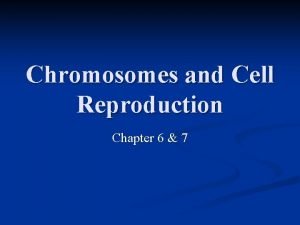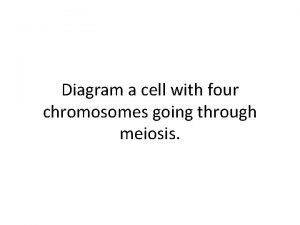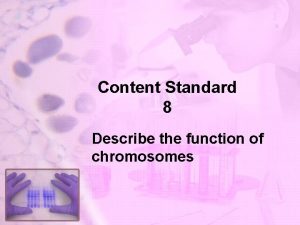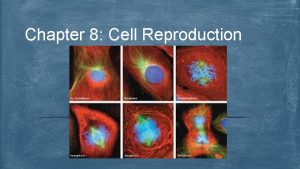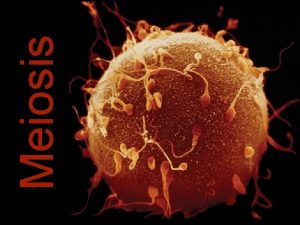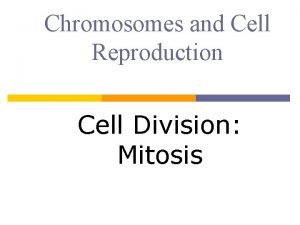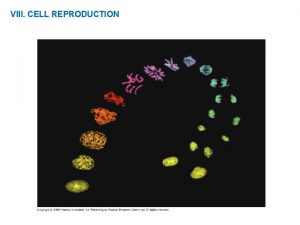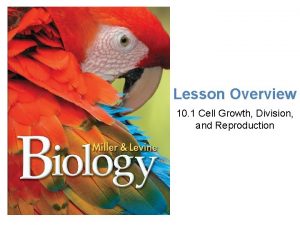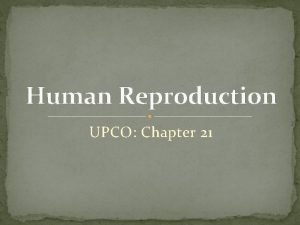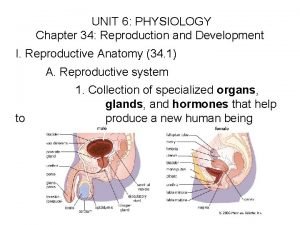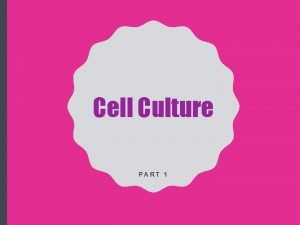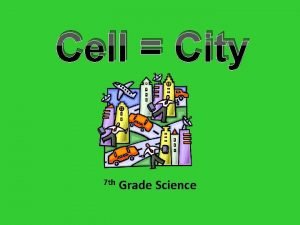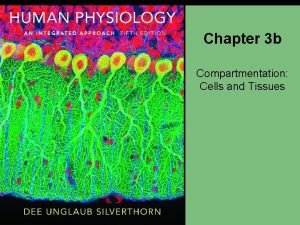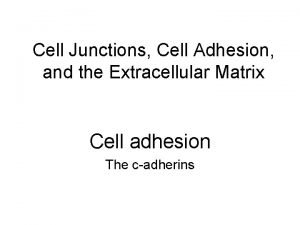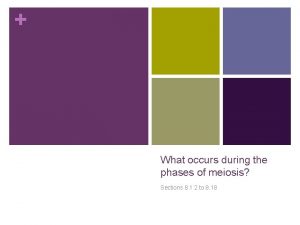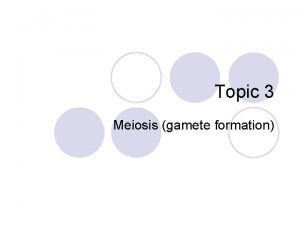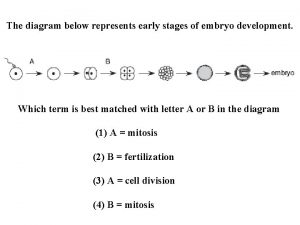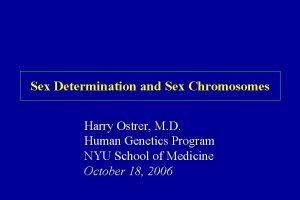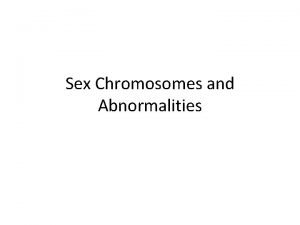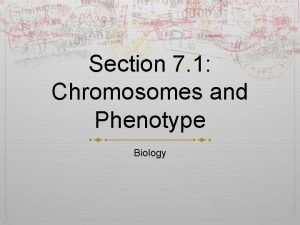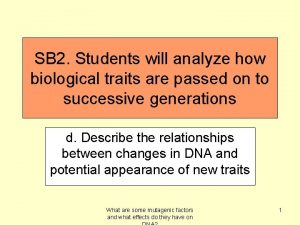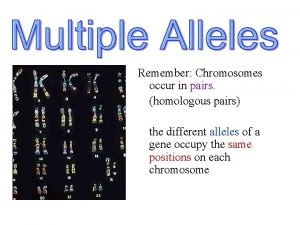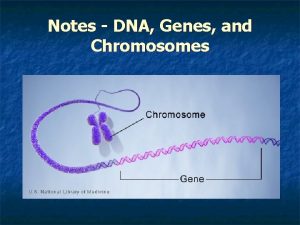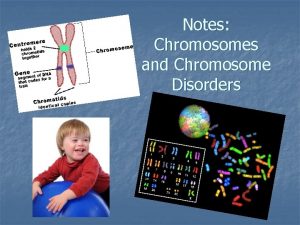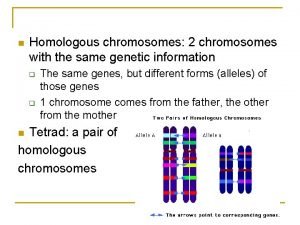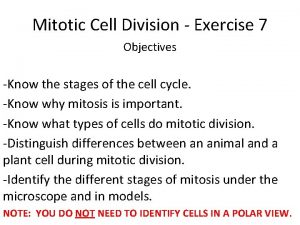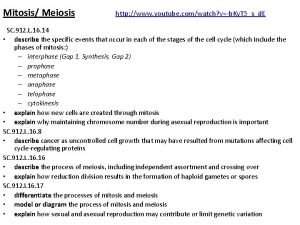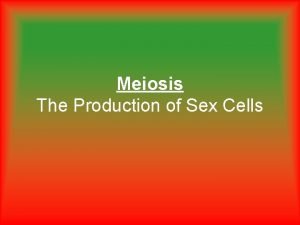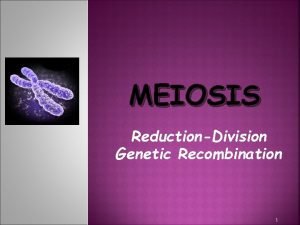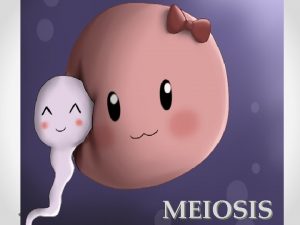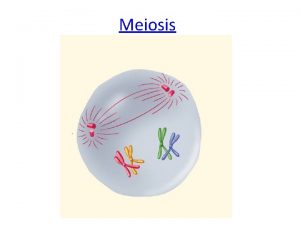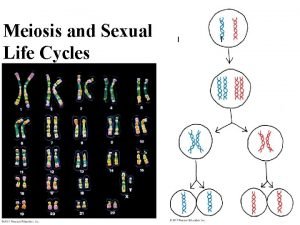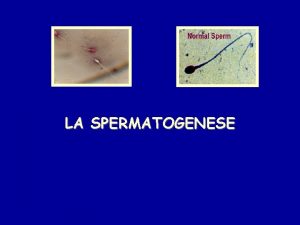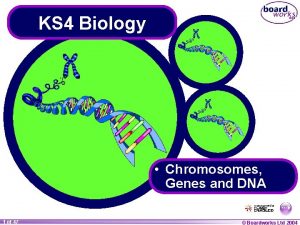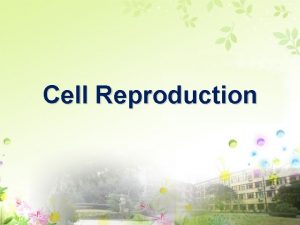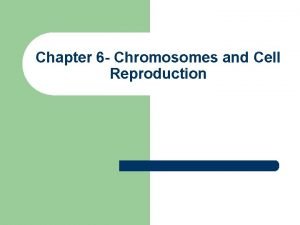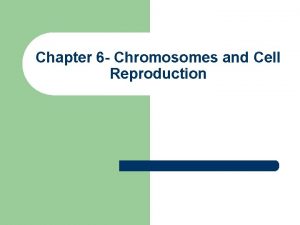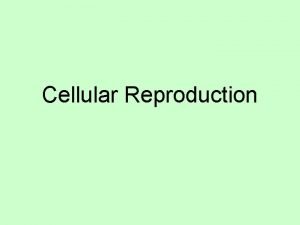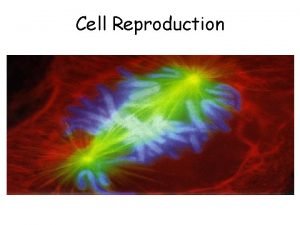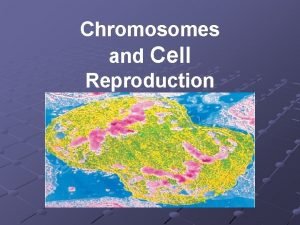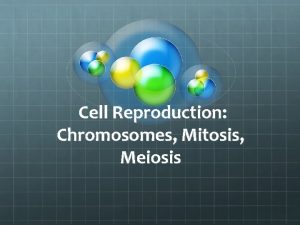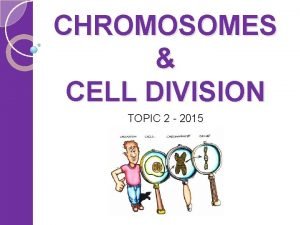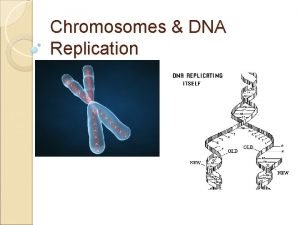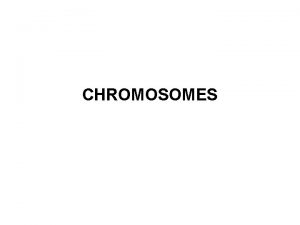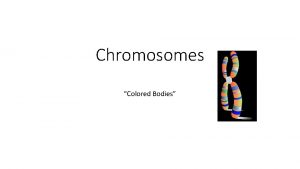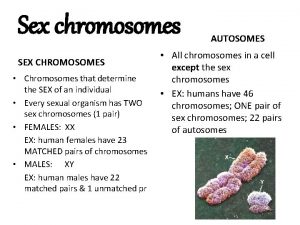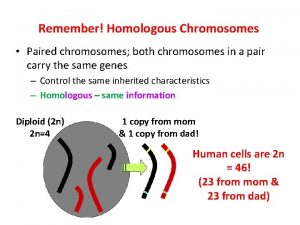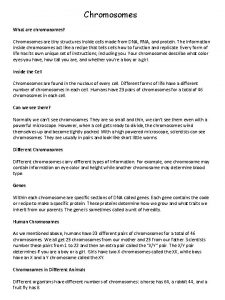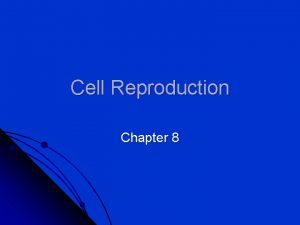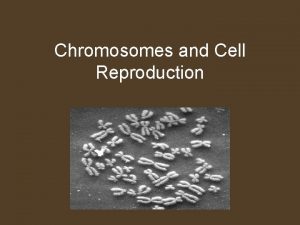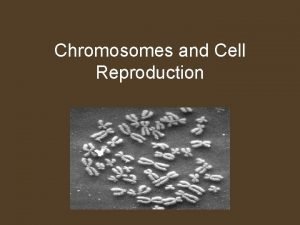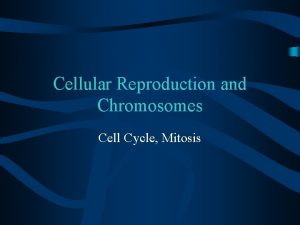Chapter 8 Cell Reproduction 8 1 Chromosomes 8



















































































- Slides: 83

Chapter 8: Cell Reproduction

8. 1 Chromosomes

8. 1 Chromosomes

8. 1 Chromosomes u https: //www. youtube. com/watch? v=x. Urlre. Ma. Urs

8. 1 Chromosomes Objectives: I will be able to: u Describe the structure of a chromosome u Identify the differences in structure between prokaryotic chromosomes and eukaryotic chromosomes u Compare u Explain the numbers of chromosomes in different species the differences between sex chromosomes and autosomes u Distinguish between diploid and haploid cells

How Chromosomes are Formed u. DNA – genetic information of the cell u“Double shape” helix

How Chromosomes are Formed u. DNA wrapped around histones u. Histone – protein that supports shape of chromosomes

How Chromosomes are Formed u. DNA wrapped around histones creates chromatin u. Chromatin histones – loosely coiled DNA and

How Chromosomes are Formed u. During cell reproduction, chromatin condenses to form tightly wound chromosomes u. Chromosomes – tightly packed bodies of DNA

How Chromosomes are Formed u. Why must the DNA be so tightly packed?

How Chromosomes are Formed u. DNA → chromatin → chromosome

How Chromosomes are Formed

Chromosome Structure u. Chromosome made of 2 chromatids u. Chromatid – 2 identical halves of a chromosome

Chromosome Structure u. Centromere – where the chromatids are attached

Prokaryote Chromosome u. Review: what are the differences between prokaryotes and eukaryotes?

Prokaryote Chromosome u. Review: what are the differences between prokaryotes and eukaryotes? u. Prokaryotes do NOT have a membrane-bound nucleus nor membrane-bound organelles!!!!!!!!!!

Prokaryote Chromosome uusually has only 1 chromosome u. Chromosome has circular DNA

8. 2 Cell Division

Sunda Colugo

8. 2 Cell Division Learning Targets I will be able to: u Describe the events of cell division in prokaryotes u Summarize the events of interphase u Describe the stages of mitosis u Compare cytokinesis in animal cells with cytokinesis in plant cells

8. 2 Cell Division https: //www. youtube. com/watch? v=Ahg. Rh. Xl 7 w_g

Prokaryote Cell Division u. Binary fission – process of cell division used by prokaryotes u. Review: what shape is prokaryotic DNA?

Prokaryote Cell Division u. Binary fission – process of cell division used by prokaryotes u. Review: what shape is prokaryotic DNA? u. CIRCULAR !!!!!

Prokaryote Cell Division

Eukaryote Cell Division Mitosis – 1 cell divides into 2 cells with same genetic material as parent cell

Cell Cycle

Interphase u 1. Interphase – time when cells are NOT dividing 2. Cell spends most of its time in interphase 3. DNA replicates (doubles) here

4 Stages of Mitosis Prophase 1. DNA turns into chromosomes and become visible 2. Nucleus disappears

4 Stages of Mitosis Metaphase 1. chromosomes move to middle of cell u“metaphase middle” =

4 Stages of Mitosis 1. Anaphase u. Chromatids get pulled apart and start moving to opposite sides of cell

4 Stages of Mitosis Telophase 1. Chromatids arrive on opposite sides of cell 2. Nucleus reforms

Cytokinesis 1. Cytoplasm separates 2. 2 new identical cells are formed

Cytokinesis u. Cleavage – where cell membrane pinches in to separate 2 new cells

Cytokinesis

Prophase Metaphase Anaphase Telophase Cytokinesis Please Make A Terrific Cake

Uncontrolled Mitosis u. Results dividing in cells that do NOT stop u. Eventually ucancer become tumors

Apoptosis u. Apoptosis –cell suicide

8. 3 Meiosis

8. 3 Meiosis (okapi)

8. 3 Meiosis Objectives I will be able to: u Compare the end products of meiosis with the end products of mitosis u Summarize the events of meiosis I u Explain crossing-over and how it contributes to the production of unique individuals u Summarize u Compare u Define the events of meiosis II spermatogenesis and oogenesis sexual reproduction

Meiosis – cell division resulting in haploid cells u Produces gametes (sperm and egg cells)

u Meiosis has 2 stages 1. Meiosis I 2. Meiosis II

Meiosis I u Called u Has reduction division 4 stages………guess what they are

Meiosis I u Has 4 phases………guess what they are 1. Prophase I 2. Metaphase I 3. Anaphase I 4. Telophase I and Cytokinesis I

Prophase I u DNA is copied here u DNA coils tightly into chromosome u Nucleus u Tetrad disappears – pair of homologous chromosomes Early Prophase I

Prophase I

Prophase I u. CROSSING-OVER HERE OCCURS u Crossing-over – parts of chromatids break off and attach to neighbor chromatids u Allows for the exchange of genetic material between chromosomes from mother and father u Genetic created recombination – new mixture of genetic material

Prophase I

Metaphase I u Tetrads line up in the middle of the cell

Anaphase I u Each homologous chromosome moves to opposite poles of cell u. Independent assortment – random separation of maternal and paternal chromosomes

Telophase I and Cytokinesis I u 2 new cells produced with half the number of chromosomes (haploid) (n)

Meiosis II u DNA is NOT copied u. Cells undergo division similar to mitosis

Prophase II u Nucleus disappears

Metaphase II u Chromosomes are aligned along the middle of the cell

Anaphase II u Chromatids separate towards opposite ends of cell

Telophase II u Nuclear envelope reforms

Cytokinesis II u Cytoplasm new cells splits forming 4

Development of Gametes u Meiosis results in 4 haploid gametes u Gamete – haploid reproductive cell u Sperm u Egg in human males in human females

Males u 4 spermatids form through meiosis u Spermatids develop into mature sperm cells through spermatogenesis

Females u Oogenesis of ova u Ova u 1 – production – mature egg cells ovum produced during meiosis

Females u Oogenesis of ova u Ova – production – mature egg cells u 1 ovum produced during meiosis u 3 polar bodies also produced u Ovum retains most of the cytoplasm u Why?

Sexual Reproduction u Production of offspring through fusion of sperm and egg u Offspring are genetically different from parents u Allows species to adapt quickly to new conditions

Asexual Reproduction u Offspring come from a single organism u Binary fission and mitosis are examples

Bellwork u With quietly your tablemate, review prophase, metaphase, and telophase (in mitosis, meiosis I, and meiosis II) u Write down a muddiest point (most confusing idea) about mitosis/meiosis, if you have one, to submit. You don’t have to include your name.

Chromosome Numbers u. Different organisms have different numbers of chromosomes

Chromosome Numbers u Different organisms have different numbers of chromosomes Organism Chromosome Number Fruit Fly 8 Pea 14 Human 46 Chimpanzee 48 Goldfish 94 Adder’s Tongue Fern 1, 262

Chromosome Numbers

Types of Chromosome u. Sex chromosomes – determine sex of an organism u. X and Y in humans u. XX = female XY = males u. Humans have 2 u. Autosomes uhumans – all other chromosomes have 44

Types of Chromosome

Autosomes u. Homologous chromosomes - 2 identical copies of each autosomes present in all cells u. One copy from each parent

Autosomes u. Genes – small segment of DNA that code for specific trait (eye color or hair color) u. Many genes located on each chromosome

Karyotype u What is a karyotype?

Karyotype u What is a karyotype? u Photomicrograph u What of chromosomes you made yesterday by cutting and gluing!!!!!!!!!!!!!!!!!!!!!!!!!!!!!!!!!!!!!!!!!!!!!!!

Karyotype u What is a karyotype? u Photomicrograph of chromosomes u What you made yesterday by cutting and gluing!!!!!!!!!!!!!!!!!!!!!!!!!!!!!!!!!!!!!!!!!!!!!!! u 22 u 2 pairs of homologous chromosomes (44 total) sex chromosomes

Karyotype (female or male)

Karyotype (what’s wrong with this picture? )

Diploid Cells u. Diploid cells – cells with 2 sets of chromosomes uall human cells (except egg and sperm cells) are diploid

Diploid Cell Abbreviation u. Abbreviated u. In as 2 n humans 2 n = 46 chromosomes

Haploid Cell u. Haploid cells – contain only 1 set of chromosomes u. Only sperm and egg cells in humans

Haploid Cell Abbreviation u. Abbreviated u. In as n humans n = 23 chromosomes

Diploid vs. Haploid Cells

3 Stages of Interphase 1. G 1 Phase – cells grow 2. S phase – DNA copied 3. G 2 Phase – preparation for cell division

Optional 4 th Stage of Interphase u. G 0 Phase – cells rest u. Resting phase
 Chapter 6 chromosomes and cell reproduction
Chapter 6 chromosomes and cell reproduction Sexual and asexual reproduction venn diagram
Sexual and asexual reproduction venn diagram Sexual reproduction and asexual reproduction
Sexual reproduction and asexual reproduction Sexual and asexual reproduction venn diagram
Sexual and asexual reproduction venn diagram Result of mitosis
Result of mitosis Functions of a chromosome
Functions of a chromosome Diploid vs haploid number
Diploid vs haploid number Diagram of mitosis
Diagram of mitosis Cell reproduction
Cell reproduction Is mitosis asexual
Is mitosis asexual Cell cycle and replication
Cell cycle and replication Cell reproduction
Cell reproduction Cell growth division and reproduction
Cell growth division and reproduction The scientist mathias schleiden studied _______ in ______.
The scientist mathias schleiden studied _______ in ______. Chapter 20 sexual reproduction in animals packet answers
Chapter 20 sexual reproduction in animals packet answers Mendelian genetics
Mendelian genetics Reproduction in humans
Reproduction in humans Chapter 9 section 1 cellular growth
Chapter 9 section 1 cellular growth Chapter 20 reproduction and pregnancy
Chapter 20 reproduction and pregnancy Chapter 19 asexual reproduction
Chapter 19 asexual reproduction Chapter 10 sexual reproduction and genetics
Chapter 10 sexual reproduction and genetics Section 1 cellular growth
Section 1 cellular growth Chapter 34 reproduction and development answer key
Chapter 34 reproduction and development answer key Chapter 9 cellular reproduction
Chapter 9 cellular reproduction Nondisjunction in meiosis
Nondisjunction in meiosis Cell city worksheet
Cell city worksheet Denuding tower
Denuding tower Prokaryotic vs eukaryotic cell
Prokaryotic vs eukaryotic cell Prokaryotic cell and eukaryotic cell similarities
Prokaryotic cell and eukaryotic cell similarities Venn diagram plant and animal cell
Venn diagram plant and animal cell Concentration cell
Concentration cell Dry cell vs wet cell
Dry cell vs wet cell Plant cell animal cell venn diagram
Plant cell animal cell venn diagram What is the function of cell wall in plant cell
What is the function of cell wall in plant cell Vacuole function
Vacuole function Rough endoplasmic reticulum function
Rough endoplasmic reticulum function Cell wall cell membrane
Cell wall cell membrane Cell strain
Cell strain Cell line vs cell strain
Cell line vs cell strain Cell city analogy answer key
Cell city analogy answer key Primary cell and secondary cell
Primary cell and secondary cell Difference between plant cell and bacterial cell
Difference between plant cell and bacterial cell Cell-cell junction
Cell-cell junction Cell-cell junction
Cell-cell junction What cell organelle is like lysol spray cleaning the cell
What cell organelle is like lysol spray cleaning the cell Section 10-2 cell division
Section 10-2 cell division Prokaryotic cell and eukaryotic cell
Prokaryotic cell and eukaryotic cell Eukaryotic cell animal cell
Eukaryotic cell animal cell Cell structures cell organelle graphic organizer
Cell structures cell organelle graphic organizer Idealized animal cell
Idealized animal cell Walker cell and hadley cell
Walker cell and hadley cell What organisms are made of eukaryotic cells
What organisms are made of eukaryotic cells Cell cycle and cell division
Cell cycle and cell division Biology.arizona.edu/cell bio/activities/cell cycle/01.html
Biology.arizona.edu/cell bio/activities/cell cycle/01.html Cell cycle chart
Cell cycle chart Matlab variable in string
Matlab variable in string Applications of electrolytic cell
Applications of electrolytic cell What is the gooey liquid in plant and animal cells
What is the gooey liquid in plant and animal cells Gamete and zygote
Gamete and zygote Cpalms heredity tutorial
Cpalms heredity tutorial How many chromosomes do humans have
How many chromosomes do humans have Chromosomes human
Chromosomes human 31 days
31 days What is variation
What is variation Is down syndrome autosomal or sexlinked
Is down syndrome autosomal or sexlinked Sex reversal
Sex reversal Xxy chromosome gender
Xxy chromosome gender Section 1 chromosomes and phenotype
Section 1 chromosomes and phenotype Frameshift
Frameshift Homologous pairs of chromosomes
Homologous pairs of chromosomes Genes chromosomes and dna
Genes chromosomes and dna Cri du chat karyotype
Cri du chat karyotype Homologous chromosomes meaning
Homologous chromosomes meaning Prophase microscope
Prophase microscope Mitosis meiosis
Mitosis meiosis Number of chromosomes in meiosis
Number of chromosomes in meiosis Sister vs non sister chromatids
Sister vs non sister chromatids Prophase
Prophase Meiosis in testes
Meiosis in testes Meiosis and mitosis
Meiosis and mitosis Chromosomes form tetrads during
Chromosomes form tetrads during Meiosis phase
Meiosis phase Spermatogonie nombre de chromosomes
Spermatogonie nombre de chromosomes What are chromosomes made of
What are chromosomes made of
